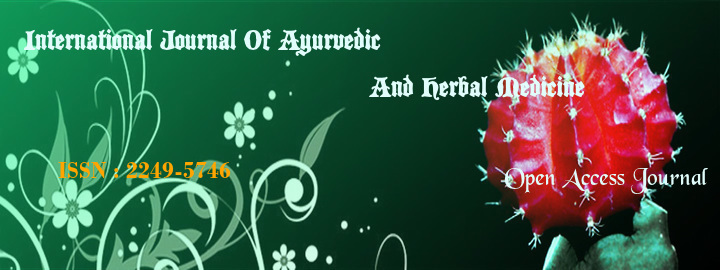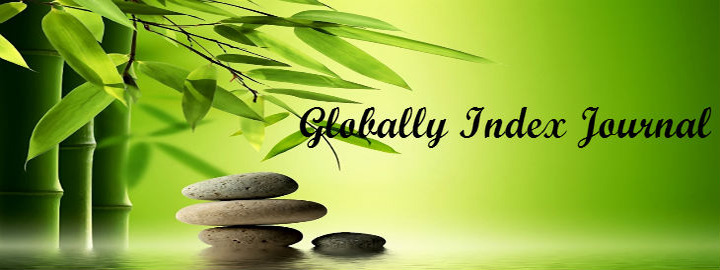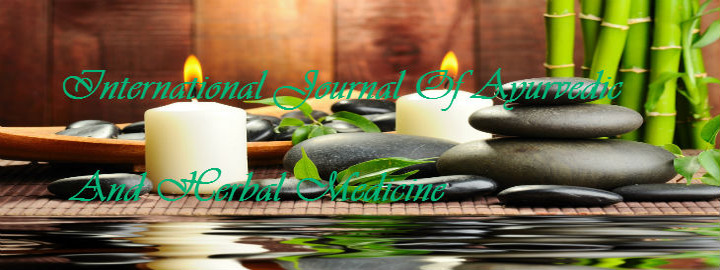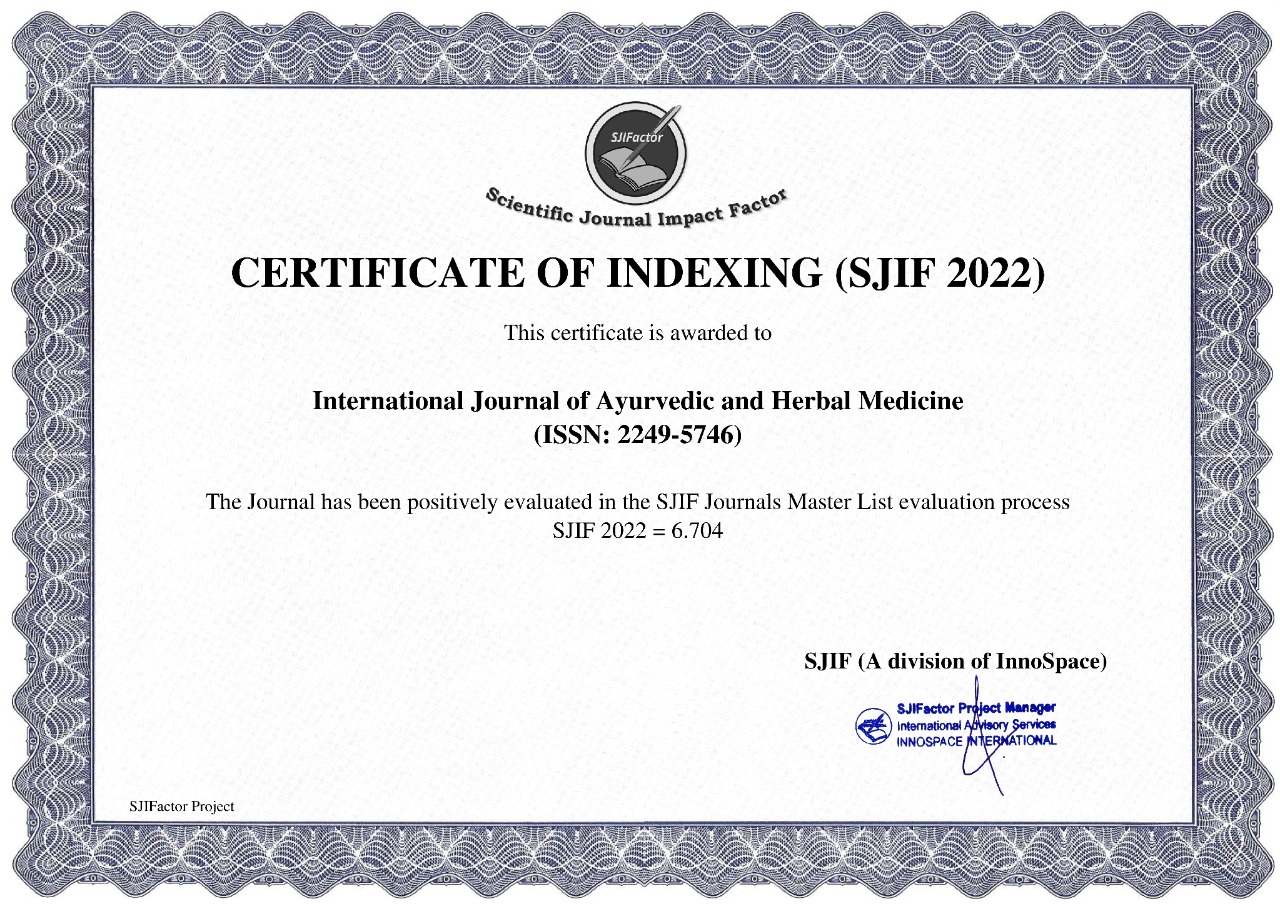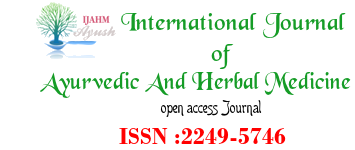


Gagan deep kour1, D. C. Singh2, Suresh Chaubey3, Ramesh Chandra Tewari4
1PG Scholar, PG Dept. of Dravyaguna, Rishikul Campus Uttarakhand Ayurveda University, Haridwar.
Email : This email address is being protected from spambots. You need JavaScript enabled to view it. , Contact Number +918439135965
2Professor & HOD, PG Dept. of Dravyaguna, Rishikul Campus Uttarakhand Ayurveda University, Haridwar.
3Associate Professor, PG Dept. of Dravyaguna, Rishikul Campus Uttarakhand Ayurveda University, Haridwar.
4Associate Professor, Dept. of Agadtantra, Rishikul Campus - Uttarakhand Ayurveda University, Haridwar, Uttarakhand, India.
Abstract
Plants have provided man with all his needs in terms of shelter, clothing, food, flavours and fragrances as not the least, medicines. The plants as medicine are used in different systems of medicine such as in Ayurveda, Allopath, Unani, Homeopathy and even in other systems. Medicinal plants are distributed across diverse habitats and landscape. A large number of medicinally important species are present in the arid zones. Of the total land area in the world, arid zones cover 18.8%. In total, 11.8% of the country is under a hot arid environment. In arid zones, vegetation is typically sparse, and is comprised of perennial and annual grasses, other herbaceous plants, shrubs and small trees. Arid zone of Rajasthan is fortunately gifted with 628 species belonging to 352 genera and 87 families. The prominent families to which the majority of the medicinal plants of the arid zones belong are Amaryllidaceae, Asclepiadaceae, Capparidaceae, Chenopodiaceae, Compositae, Cucurbitaceae, Labiatae, Leguminosae, Liliaceae, Solanaceae, Zygophyllaceae and Umbelliferae. Plants of Zygophyllaceae family taken in this paper have high therapeutic value and some important medicinal uses of these plants are mentioned in different Ayurveda Treatise but this traditional medicine needs to be evaluated, given due recognition and developed so as to improve its efficacy, safety, availability and wider application at low cost. Some of the medicinal uses given in Ayurveda Treatise are still in the books only. These uses still need to be evaluated so as to make them more practicable in the present health era. So this paper is an attempt of the author to create greater awareness amongst the people as a whole about the medicinal values of these plants of Arid zone, so that this heritage may be wisely used and conserved and perpetuated through judicious management in Health sector.
KEY WORDS : Arid zone, Zygophyllaceae, Medicinal plants, Dhanvyasa, Gokshuru, Harmala.
REFERANCES
1. Jhakar M.L., B.L. Kakralya, S.J. Singh and K. Singh 2004.Enhancing the export potential of medicinal plants through biodiversity conservation and development under multi-diversity environment.In : Medicinal Plants Utilization and Conservation. pp. 36-78. (ed. P.C. Trivedi). Avishkar publishers. India.
2. F .R. Bharucha and V. M. Meher-homji, On the floral elements of the semi-arid zones of India and their ecological significance (http://onlinelibrary.wiley.com/doi/10.1111/j.1469-8137.1965.tb05403.x/pdf)
3. Arun K Sharma and J.C. Tiwari, Forests and Forest plants Vol II – Arid zone Forestry with special reference to Indian Hot Arid Zone.
4. Bhandari, M.M.1995. Flora of Indian Desert, MPS Repros, Jodhpur.
5. B.B.S.Kapoor and Swati Lakhera, Ethnomedicinal plants of Jodhpur District, Rajasthan used in herbal and folk remedies, Indian J.Pharm.Biol.Res. 2013; 1(4):71-75
6. Jain S.K. Medicinal plants. National Book Trust, India, PP.3, 1996.
7. http://demo1.tmag.tas.gov.au/treatments/families/Zygophyllaceae/Zygophyllaceae_2009_1.pdf
8. Kirtikar K.R. and Basu B.D., Indian Medicinal Plants, Edited by E. Blatter, J.F. Caius and K.S. Mhaskar, Vol. 1,Dehradun : International book distributors; 1994.p.
9. Ibid; p.427
10. Khare CP. Indian Medicinal Plants: An Illustrated Dictionary. New York USA; Springer Publications: 2007.
11. Y. D. Gaur, Raj Kumar Gupta, B. K. Dutta, S. P. Malhotra . Medicinal plants of the indian arid zone, Journal of agriculture tropicals, Volume 13 : 13-6-7; pp. 247-288
12. Prof. Dr. Gyanendra Pandey, Dravyaguna Vijnana, Varanasi : Chaukhamba Krishnadas Academy, Vol. 1, 4th Edition; p.575
13. Agnivesha, Charaka Samhita, Commentary by Pt. Kashinatha Shastri and Dr. Gangasahaya Pandeya, Part II, Varanasi: Chaukhamba Sanskrit Sansthan, Reprint : 2006; p. 152
14. Ibid; p. 367
15. Ibid; p. 401
16. Ibid; p. 509
17. Shastri-Ambikadatta - Sushruta Samhita part II , Chaukhamba Sanskrit Sansthan, Varanasi, Reprint : 2005; p. 222
18. Vagbhata, Ashtanga Hridayam, Collated by Dr. Anna Moreswara Kunte and Krishna Ramchandra Shastri Navare, Varanasi : Chaukhambha Orientalia, Reprint : 2005; p. 675
19. Shri Chakrapanidatta, Chakradatta, Commentary by Dr. Indradeva Tripathi, Varanasi : Chaukhambha Sanskrita Sansthana, Reprint : 2005; p. 121
20. Khare CP. Indian Medicinal Plants: An Illustrated Dictionary. New York USA; Springer Publications: 2007.
21. Kabir Md. Sohel, Kaiser Hamid, Latifa Bulbul, Zubaida Khatun, Md. Zahid Alam, Paritosh Chakma. 2010. Effect of ardhabilva kvatha curna - an ayurvedic formulation on lipid profile after chronic administration. Agriculture and biology journal of North America 1(5): 812-816.
22. Meena A. K., M. M. Rao. 2010. Folk herbal medicines used by the Meena community in Rajasthan. Asian Journal of Traditional Medicines 5 (1): 19-31.
23. Lam, Matt, Amtul R. Carmichael, and Helen R. Griffiths. “An Aqueous Extract of Fagonia Cretica Induces DNA Damage, Cell Cycle Arrest and Apoptosis in Breast Cancer Cells via FOXO3a and p53 Expression.” Ed. Pranela Rameshwar. PLoS ONE 7.6 (2012): e40152. PMC. Web. 21 Aug. 2015.
24. D. Senthil Nagaraj, Antihyperlipidemic activity of Fagonia cretica L. whole plant. Inter. J. of Pharmacotherapy / 3(2), 2013, 52-54.
25. Quattrocchi U. CRC world Dictionary of Plant Names. Vol. IV, CRC press, Boca Raton, London, New York, Washington, D. C., 2000, 2708.
26. Ross IA. Medicinal plants of the world. Chemical Constituents, Traditional and Modern Uses. Vol. II, Humana Press Inc., 2001, 411‒426
27. Dimitrova DZ, Obreshkova D, Nedialkov P. Antioxidant activity of Tribulus terrestris– a natural product in infertility therapy. Int J Pharm Pharm Sci, 2012; 4(4): 508-511.
28. Khare CP. Indian Medicinal Plants: An Illustrated Dictionary. New York USA; Springer Publications: 2007.
29. Gauthaman K, Adaikan PG. Effect of Tribulus terrestris on nicotinamide adenine dinucleotide phosphate-diaphorase activity and androgen receptors in rat brain. J Ethnopharmacol, 2005; 96(1-2):127-32
30. Dr. K.M. Nadkarni, Indian Materia Medica, Bombay Popular Prakashan, Reprint : 2007; p. 1230
31. Dr. J.L.N. Shastry, Dravyaguna Vijnana, Vol. II, Varanasi : Chaukhambha Orientalia, Reprint : 2014; p. 99
32. Agnivesha, Charaka Samhita, Commentary by Pt. Kashinatha Shastri and Dr. Gangasahaya Pandeya, Part II, Varanasi: Chaukhamba Sanskrit Sansthan, Reprint : 2006; p. 646
33. Ibid; p. 648
34. Ibid; p. 154
35. Priya Vrat Sharma, Classical uses of Medicinal plants, Varanasi : Chaukhambha Vishwabharati, Reprint : 2004; p. 133
36. Vagbhata, Ashtanga Hridayam, Collated by Dr. Anna Moreswara Kunte and Krishna Ramchandra Shastri Navare, Varanasi : Chaukhambha Orientalia, Reprint : 2005; p.927
37. Vaidya Sodhala, Gadanigraha. Commentary by Shri Indradeva Tripathi, Part III, Varanasi : Chaukhambha Sanskrita Sansthana, Reprint : 2005; p. 716
38. Dr. Shailaja Srivastava, Sharangadhar Samhita, Varanasi : Chaukhambha Orientalia, Reprint : 2005; p. 430
39. Kor NM, Zadeh JB, Kor ZM. Physiological and pharmaceutical effects of Tribulus terrestris as a multipurpose and valuable medicinal plant. Int J Adv Biol Biom Res, 2013: 1(5): 556-562
40. Bhattacharjee SK. Handbook of Medicinal plants. Jaipur, Pointer Publishers: 2004, pp.353.
41. Costa M, Andersen ML, Hachul H, Tufik S. Medicinal plants as alternative treatments for female sexual dysfunction: utopian vision or possible treatment in climacteric women? J Sex Med, 2010; 7(11):3695-714. doi: 10.1111/j.1743-6109.2010.01987.x.
42. Mikaili P, Sharifi M, SHayegh J, Sarahroodi SH. Etymological review on chemical and pharmaceutical substances of the oriental origin. Int J Anim Vet Adv. 2012;4:40–4.
43. El Gendy MA, El-Kadi AO , Eganum harmala L. differentially modulates cytochrome P450 gene expression in human hepatoma HepG2 cells. Drug Metab Lett. 2009 Dec; 3(4):212-6.
44. Dr. Ravindra Sharma, Medicinal plants of India – An Encyclopaedia, Delhi : Daya Publishing House, 2003; p. 184.
45. Cardiovascular actions of three harmala alkaloids: harmine, harmaline, and harmalol. Aarons DH, Rossi GV, Orzechowski RF J Pharm Sci. 1977 Sep; 66(9):1244-8.
46. Hamsa TP, Kuttan G Eur J Pharmacol. 2010 Dec 15; 649(1-3):64-73.
47. Abortifacient potential for the epigeal parts of Peganum harmala. Shapira Z, Terkel J, Egozi Y, Nyska A, Friedman J J Ethnopharmacol. 1989 Dec; 27(3):319-25.
48. Abortifacient potential for the epigeal parts of Peganum harmala. Shapira Z, Terkel J, Egozi Y, Nyska A, Friedman J J Ethnopharmacol. 1989 Dec; 27(3):319-25.
Mahmoudian M, Jalilpour H, Salehian P. Toxicity of Peganum harmala: Review and a case report. Iran J Pharmacol Ther. 2002;1:1–4
index







